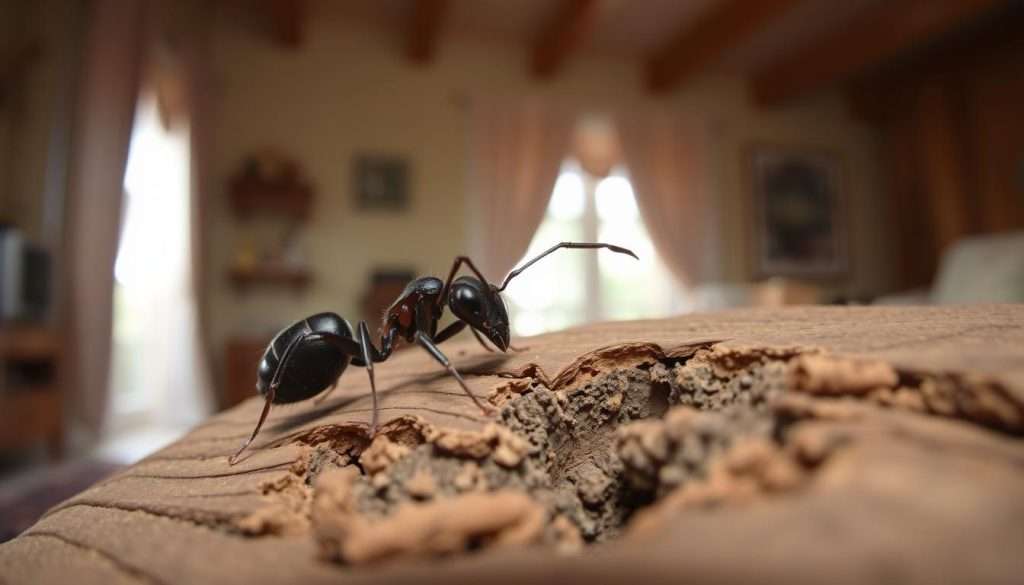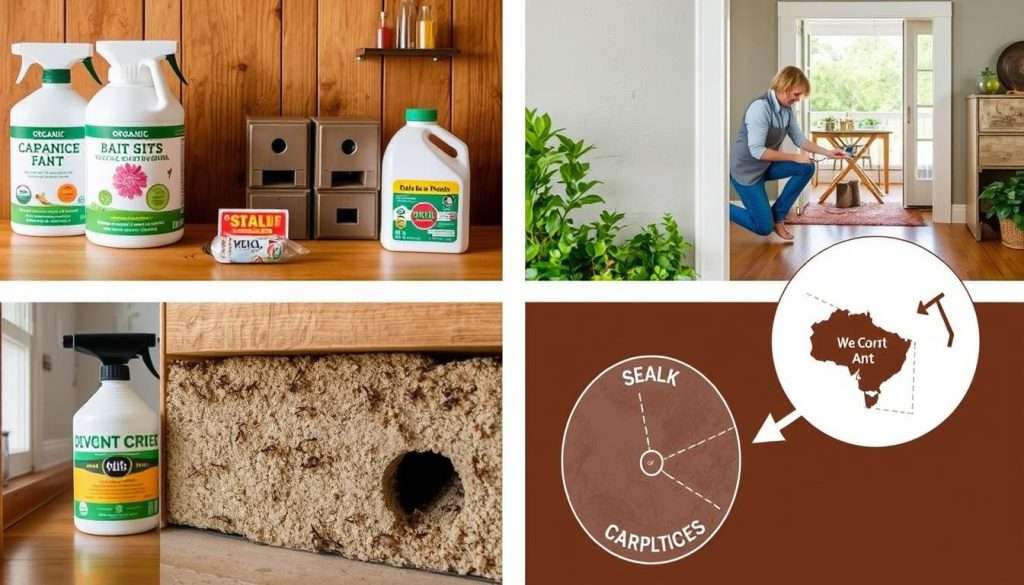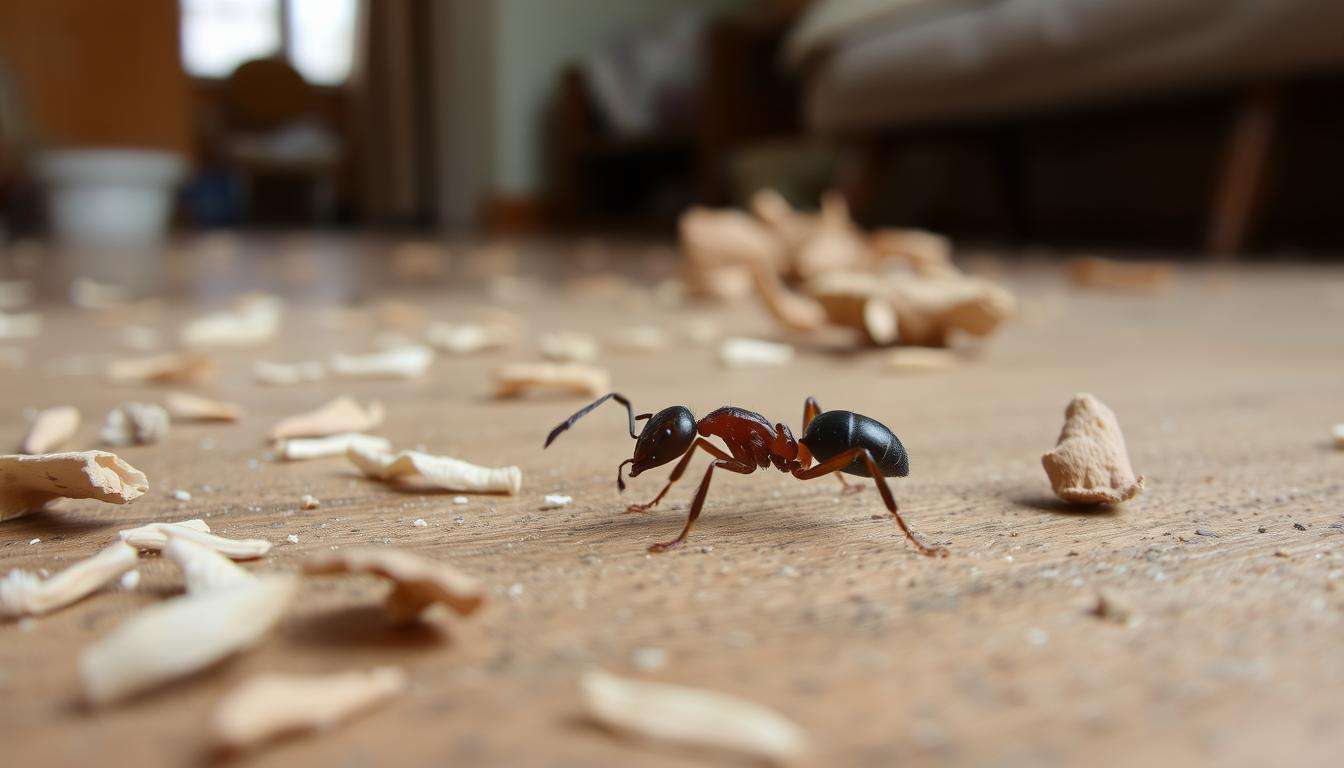Carpenter ants can harm your home by digging into wood. They are often confused with termites. In the U.S., there are over 700 types of ants, and carpenter ants are among the most troublesome.
They are a big problem in warm places where they can live all year. Knowing if carpenter ants are a threat to your home is important. They can cause expensive damage. A big carpenter ant colony can have more than 10,000 workers.
Learning about their habits and how to stop them is key to protecting your home.
This guide will teach you how to spot carpenter ants and how to control and prevent them. We’ll look at ways to keep your home safe and free from pests.
Key Takeaways
- Carpenter ants can be as damaging to homes as termites.
- They thrive in cool, damp climates, often nesting in wet wood.
- Preventing carpenter ants includes eliminating moisture sources and maintaining your property.
- A mature colony can consist of over 10,000 worker ants.
- Pest control services like Viking Pest Control can help manage and prevent infestations effectively.
- Routine property inspections are essential in identifying early signs of infestation.
Understanding Carpenter Ants
Carpenter ants are found in many places, especially in Texas. Knowing how to spot them and their habits is key to managing them.
Identification of Carpenter Ants
Carpenter ants can be 1/4 to 5/8 inches long. Their colors range from yellowish-red to solid black. They have a smooth body with a single node between their abdomen and thorax.
It’s important to tell them apart from termites. Carpenter ants usually don’t live in homes with termites.
They like to nest in hollow trees and wooden areas in homes. Their nests are often in damp or decayed wood. They invade homes at night, using tree branches and narrow paths.
Life Cycle and Behavior
The queen lays eggs that take years to hatch. A colony can have thousands of worker ants. These ants eat a wide variety of foods, including plants and animals.
They prefer softwood or rotting wood but can also damage sound wood. This can cause a lot of damage over time.
Foraging ants, about 10% of the colony, can carry toxic baits back to their nests. Chemical controls like pesticides and desiccant powders work well against them. Knowing their behavior helps in preventing and treating infestations.
Getting help from pest management experts is a good idea. It shows how important understanding their life cycle and habits is for a pest-free home.
Are Carpenter Ants Dangerous?
It’s important for homeowners to know about carpenter ants. They don’t sting or bite like other pests. But, they can still harm your home.
Potential Damage to Homes
Carpenter ants make tunnels in wood. This weakens parts of your house, like beams and joists. They don’t eat wood, but their tunnels can still damage your home a lot.
Moist areas like attics and wall voids attract them. If carpenter ants are there, your home could get damaged. This could cost a lot to fix, even tens of thousands of dollars.
Effects of Carpenter Ant Infestations
Carpenter ants can also cause other problems. They might get into your food in the kitchen. This can make your food unsafe to eat.
They can make noise in the walls or leave sawdust piles. These signs mean they’re there. It’s important to catch these signs early to avoid expensive fixes.

Signs of Carpenter Ant Infestation
It’s important to know the signs of carpenter ant infestation. These carpenter ant signs mean you might need a pro. Knowing the damage they do helps you act fast to protect your home.
How to Spot Carpenter Ant Damage
Look for these carpenter ant damage indicators:
- Small holes in wood that look like windows, made by ants.
- Sawdust or frass (wood shavings with droppings) under wooden things.
- Noises in walls or woodwork, especially at night.
- Wood that looks wet, which might mean ants are nesting there.
- Trails of ants leading to nests or food, seen at dusk or dawn.
Other Indicators of Infestation
Spotting carpenter ants means looking for more signs. Check these:
- Ants inside, especially worker ants that are about 0.5 inches long.
- Winged ants near windows, which might mean a big nest.
- Wood shavings where ants live.
- Ants themselves, more active at night, showing their paths.
Carpenter Ant Control Strategies
Controlling carpenter ants needs a mix of DIY and professional help. You can use many methods to keep them away and treat infestations. Knowing the best ways to control carpenter ants is key to a pest-free home.
Effective Treatment Options
There are several ways to manage and get rid of carpenter ants:
- Boric Acid Mixture: Mixing boric acid with powdered sugar makes a bait that kills whole colonies.
- Slow-Acting Bait: Slow-acting bait lets ants carry it back to their nests, killing more ants.
- Insecticide Sprays: Spraying insecticides in areas where ants are seen can work fast.
- Diatomaceous Earth: This natural option dries out and kills ants on contact, great for quick action.
- Non-Toxic Barriers: Creating a barrier around your home keeps carpenter ants out, a good prevention.
Seeking Professional Help
If DIY methods don’t work or if you have a big problem, get help from pest control experts. They can find nests and treat them. Many offer ongoing services to keep pests away. Quick action helps avoid serious damage to your home.

Carpenter Ant Prevention Tips
Keeping carpenter ants out of your home is key to a pest-free space. By using smart practices, you can lower the risk of these pests making your home their home.
Best Practices for Homeowners
Here are some tips to help prevent carpenter ants:
- Regularly inspect and repair any cracks or holes in the home’s exterior, which can serve as entry points.
- Reduce moisture levels around the property using dehumidifiers and promptly addressing leaks from roofs and plumbing.
- Ensure that food messes in the kitchen and dining areas are cleaned thoroughly to minimize attractions.
- Store firewood away from the home and raised off the ground to discourage nesting.
- Keep tree branches and shrubs trimmed back from the house to limit access points.
Maintaining a Pest-Free Environment
Keeping your home maintained is crucial for carpenter ant prevention. Knowing what attracts these pests is key. Items like:
| Material | Common Issue |
|---|---|
| Gardening woods | High moisture content, prime for nesting |
| Raw building materials | Potential entry for moisture-loving ants |
| Landscaping turf | Moist environments can encourage activity |
| Transplanted trees or shrubs | Vegetation contact is a primary entry method |
Being proactive with these steps helps keep carpenter ants away. Keeping your home pest-free means regular prevention and smart habits.
Conclusion
Carpenter ants are a big problem for your home. They can dig into wood to make nests. Knowing about the 24 different types, like black and red ones, helps prevent them.
These ants can live in huge colonies, causing a lot of damage. To keep your home safe, learn about their habits and how to spot damage. Also, take steps to stop them before they start.
To keep carpenter ants away, check for damp wood and seal cracks. Look for signs like sawdust or big ants. If you see these, call a pro fast. Carpenter ants can damage more than termites.
By following these tips, you can keep your home safe and sound. For more info on spotting carpenter ants, check out how to spot this devastating pest. Act quickly to protect your home from these pests.
